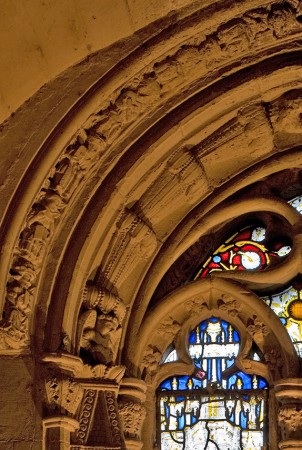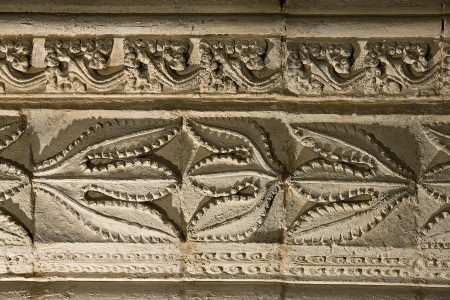I too am back from my summer holidays, but with a somewhat smaller haul of goodies. Two items only, and this is the first.
Take a look at this carving, part of the arch around a window in Rosslyn Chapel outside Edinburgh, more formally known as the Collegiate Chapel of St Matthew.
Do those things in the wider arch look to you like ears of maize?
And how about this? Do those stylised, possibly spiky three-leaved things look like an aloe, or, as the Rosslyn Chapel Photographic CD would have it, a cactus?
If they did, that would be a mystery indeed, because the chapel was completed in 1484, eight years before Columbus sailed to the New World, source of cacti and maize. There is, of course, a simple explanation: Henry I Sinclair, Earl of Orkney and grandfather of the Rosslyn Chapel’s founder, William Sinclair, sailed to North America in around 1398, brought back samples (or at least depictions) of maize and aloe (or cacti), which the chapel masons 1 incorporated into these carvings, all subsequent history of the incident being scrupulously hidden from history’s view.
Not having read or seen it, I was unaware that The Da Vinci Code makes much of Rosslyn Chapel and its Masonic and Templar associations, but frankly, I’m not in the least bit convinced that those carvings are what people say they are. And in that, I’m not alone. The BBC pours cold water on the idea too.
Undaunted, however, I’ll be scrutinizing the son-et-lumiere at Machu Pichu for evidence of neeps among the tatties.


I’ve always thought the “cacti ones” could just as easily be fig leaves if you squint at them the right way.
Your first picture could join this collection.
I’m thinking stylized wheat or perhaps tulips.
There are aloes all over the place in Africa – why should they be thought to be Agave/cactus? I’ll go along with the BBC report.
Aloe is native to Africa, not America
I feel a little silly saying this but obviously this article should be renamed ‘Cornspiracy’. Am I the only one that can see this?!!
Good point, well made.
Well a few points to blow this out the water. First off the Spanish went to ‘Mexico’ and the lower areas in the 1400 so they could have bought back ‘corn’. Columbus didn’t discover America anyway.
And the main point is…
They are thistle leaves. Native to Scotland and its national emblem.
As usual, mention Dan Brown or David Icke and objectivity immediately flies out the window. Who is to say Henry Sinclair didn’t visit America? – It’s perfectly feasible if not actually proven.
And if the BBC is denying it, then there’s definitely something in it.